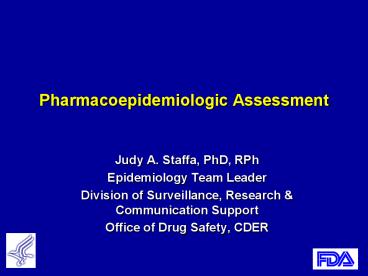Pharmacoepidemiologic Assessment PowerPoint PPT Presentation
1 / 14
Title: Pharmacoepidemiologic Assessment
1
Pharmacoepidemiologic Assessment
- Judy A. Staffa, PhD, RPh
- Epidemiology Team Leader
- Division of Surveillance, Research
Communication Support - Office of Drug Safety, CDER
2
When and why are pharmacoepidemiologic studies
recommended?
- To further characterize potential safety signals
from controlled clinical trials - chronic exposures
- patients with co-morbid conditions
- To further evaluate and quantify a safety signal
identified after approval - incidence rate vs. reporting rate
3
Pharmacoepidemiologic Study Design
- Cohort
- Case-control
- Nested case-control
- Hybrid designs
4
Minimum Requirements for a Good
Pharmacoepidemiologic Study Protocol
- Clearly specified study objectives
- Critical review of the literature
- Detailed research methods
- Study population
- Data sources
- Projected study size
- Methods for data collection/management/analysis
5
Studies using Automated Data Factors
affecting Choice of Database
- Demographics of patients
- Turnover rate/mobility
- Plan coverage of study medications
- Size of population available for study
- Availability of outcomes of interest
- Coding of outcomes of interest
- Access to medical records
6
Registries
- A systematic collection of defined events or
product exposures in a defined patient population
for a defined period of time
7
Good Registry Protocols
- Objectives
- Literature review
- Detailed research methods
- Patient recruitment and follow up
- Projected sample size
- Methods for data collection, management and
analysis - Carefully designed data collection forms
- Validation of findings
8
Surveys
- Further evaluate safety signals
- Assess knowledge of labeled events
- Assess product use
- Assess compliance with risk management programs1
- Address proprietary name confusion
1Concept Paper Risk Management Programs
9
Good Survey Protocols
- Objectives
- Detailed research methods
- Patient or provider recruitment and follow up
- Projected sample size
- Methods for data collection, management and
analysis - Carefully designed survey instruments
- Validation of findings
10
Reporting Safety Signals to FDA
- Submit a synthesis of all available safety
information - Provide an assessment of the risk/benefit profile
of the product - Propose steps to further investigate through
additional studies - Propose risk management programs as appropriate1
1Concept Paper Risk Management Programs
11
FDAs Assessment of Safety Signals
- Magnitude of the signal
- Precision of the signal
- Consistency of findings across available data
sources - Biological plausibility
- Seriousness of the event
- Degree of benefit
- Availability of other therapies
- Mitigate events occurring in population(s)
through risk management programs1
1Concept Paper Risk Management Programs
12
Questions for Public Comment
- Under what circumstances would a registry be
useful as a surveillance tool and when would it
cease to be useful?
13
Questions for Public Comment
- Under what circumstances would active
surveillance strategies prove useful to identify
as yet unreported adverse events?
14
Questions for Public Comment
- Under what circumstances would additional
pharmacoepidemiologic studies be useful?

